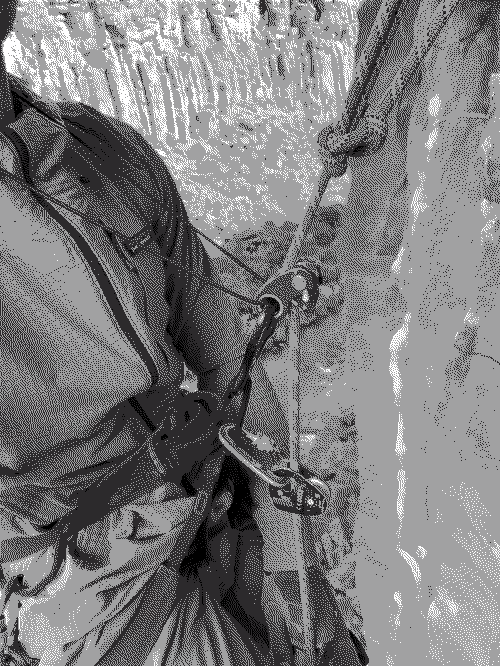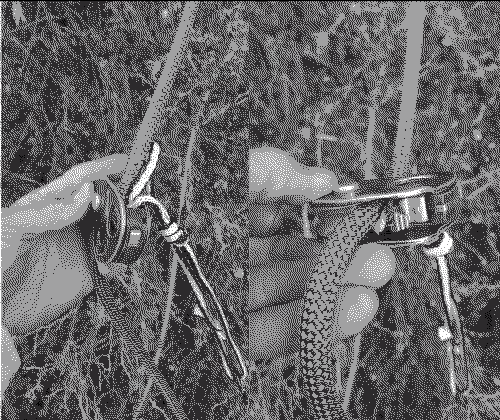
I mentioned in a few articles before that I took up rope solo. Specifically top rope solo as would any poor or eager outdoor climber has considered. Now that I have more experience from my TRS excursions and constant practice I wanted to lay out my understanding of the fundamentals and niche talking points of the subject. As always
TRS demands attentiveness to the subject just as much as every other climbing system. In fact the basis of a quality TRS setup is the climbers ability to produce a redundant, safe, and equalized anchor in the outdoors, whether it be 2 bolts, a bear hug width tree, or a couple nuts strung together by a cordellete. Then to assemble your fixed line comes the decision of 1 or 2 strands. 1 Strand gives much more rope if the climb in tall however 2 independent strands give you redundancy in equivalence to a rope access backup device especially if you were to be mainly falling on 1 cord over the other. However during the rappel, one of the most crucial factors begins here.
Most sport climbers have very little to worry about when it comes to the shredding of ropes due to rock as most routes leave little chance of this occurring. However with any fixed line, it is critical to be completely aware and prevent the rubbing and shredding of ropes over rock. Even worse, when loaded a fat rope will shred itself easily when even the slightest of rubbing occurs on sharp rock. Bringing multiple forms or rope pro is vital to fix to portions that will or could get cut. In situations where you are top roping off a anchor above the cliff edge its best to re-anchor into somewhere below the anchor if possible as both a backup and a safety net as the cliff edge wont be taking the brunt of a taught rope.
When you get to the ground and its time to assemble your devices.

In Kirkpatricks book “On the Line” he features a page where he condenses his teachings on TRS; in his one word segment, he writes “Redundancy”. In my new experience, I had gone to see 2 climbers so far employing the use of a single device as their TRS system, every time using a microtraxion. These individuals often climb harder and had more experience than me but are those scoffs and hand waves deserved when I say they should double up on devices?
The issue with TRS systems is that no device is perfect. There is no one device redundant foolproof perfect system. Every device will have its pro's and con's, some seemingly perfect and widely used still can be functionally overturned and end up killing you. It is paramount to use 2 devices, any less is a dance with death.
So what devices to choose? Although never directly stated, a lot of devices out on the market work well enough for the task at hand. 2 Microascenders on a single or separated into a double strand has been a very popular method that many and I use. A belay device like the Trango Vergo works well especially for taking the brunt of falls and quick rappels.
Starting out I was very wary of falling, almost thinking of a TRS system just as if I was free soloing a route. However with practice and understanding of the systems at play, TRS can be very safe and give the lightest of catches. A way that improves the safety and functionality of devices in this configuration is the positioning of these devices itself. Positioning your TRS devices high above the waist by the use of a rigged chest harness lessens the forces of a fall in contrast to a device on the belay loop, in where the device has to complete a 180degree distance, plus the distance of your belay loop and carabiner itself.
I rig my TRS harness by using a 120cm sling crossed once to form an X. I bring it to my back and put both arms through the holes formed, then girth hitching a locker onto the sling loops that are on my chest. Clipping said locker into some accessory cord that are connected to my TRS devices finally brings them taught to my chest allowing me to take soft falls on them all day.
There is much more to learn when it comes to TRS systems. I heavily recommend reading Andy Kirkpatrick's book “On the Line” as a basis of understanding on the subject before taking other people's advice. Even with my few years of climbing experience ive already seen people taking an unnecessary amount of risk whether it be from the misunderstanding of online discussion or the lack of knowledge of the systems used. As always here are a few resources to get you started
Kirkpatricks On the Line Yann Camus Lots of TRS articles